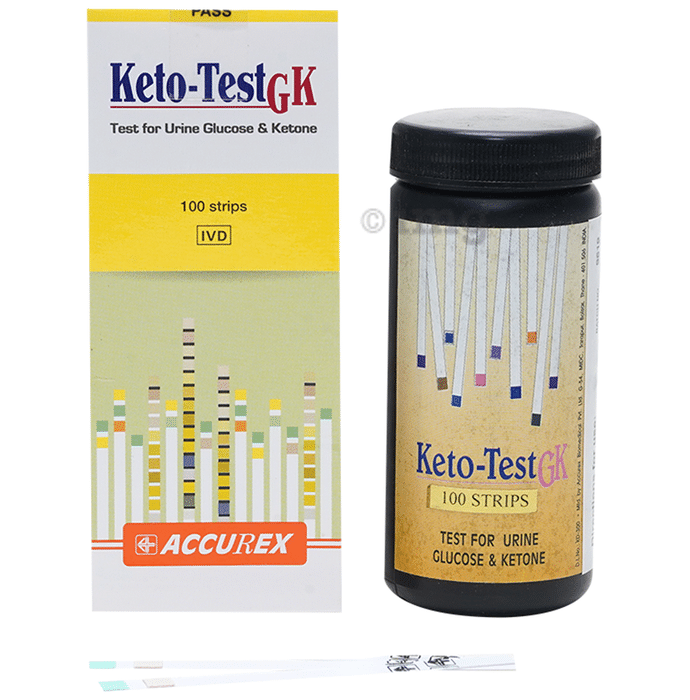



Keto-Test GK Test Strip
Product highlights
- Used for semi-quantitatively estimating glucose and ketone in urine samples
- Disposable and ready-to-use plastic strip affixed with two reagent areas for testing, one for glucose and the other for Ketone
- Packed in an air-tight plastic bottle containing a desiccant
- When dipped in the urine sample, the strip colour is read visually within 40 seconds, requiring no additional laboratory equipment for testing
₹550
₹550+ free shipping with

Inclusive of all taxes
1 Box
SOLD OUT
Additional offers
Special offer: 100 % Off Use coupon PAYMENT-CART-100 in cart.
Information about Keto-Test GK Test Strip
Keto-Test GK Test Stripis a test strip used for semi-quantitatively estimating glucose and ketone in urine samples. It is a disposable and ready-to-use plastic strip affixed with two reagent areas for testing, one for glucose and the other for Ketone. The Keto-TestGK test strips are packed in an air-tight plastic bottle containing a desiccant. When dipped in the urine sample, the strip colour is read visually within 40 seconds, requiring no additional laboratory equipment for testing.
Uses: For semi-quantitatively estimating glucose and ketone in urine samples
Product Features and Specifications:
Glucose:
Ketone:
Directions For Use:
Storage and Safety Information:
Uses: For semi-quantitatively estimating glucose and ketone in urine samples
Product Features and Specifications:
Glucose:
- This test is based on a double sequential enzyme reaction
- Glucose oxidase converts urine glucose to gluconic acid and hydrogen peroxide
- Subsequently, peroxidase converts hydrogen peroxide into water and nascent oxygen
- The nascent oxygen liberates iodine from potassium iodide to produce colours ranging from green to brown depending on the urine glucose concentration
Ketone:
- The test is based on the principle of Rothera's test
- In this reaction, acetoacetic acid in an alkaline medium will react with sodium nitroprusside to produce a purple colour
- The term ketones represents three intermediate products of fat metabolism, namely acetone, acetoacetic acid and B-hydroxybutyric acid
- The test strip is specific only to acetoacetic acid
- It does not measure B-hydroxybutyric acid and is only slightly sensitive to acetone if glycine is present
Directions For Use:
- This procedure must be followed strictly to achieve reliable results
- Collect fresh, well-mixed, uncentrifuged urine in a clean and dry container
- Remove one strip at a time from the bottle and replace the cap immediately and tightly
- Dip the reagent areas into urine for 1 to 2 seconds. While removing the strip from the urine, run the edge along the container’s wall and tap to remove excess urine from the strip
- Hold the strip close to the colour chart provided on the label and match carefully. The colour chart should be matched under good light (but not direct sunlight). The glucose results should be read at 30 seconds, and the ketone results at 40 seconds
- Avoid touching the strip directly on the colour chart, as this will soil the chart. Interpret the results of the colour obtained falls between two adjacent colour blocks. Colour changes that occur after 40 seconds are of no quantitative diagnostic value
Storage and Safety Information:
- Do not transfer the strips from their original bottle to any other bottle
- Do not remove the desiccant from the bottle
- Replace the cap immediately and tightly after removing the reagent strips to maintain reagent reactivity
- Keto-lestGK should be protected from moisture; this will prevent deterioration during storage
- Care must be taken not to touch the test reagent areas of unused strips
- All test reagent strips must be used within four months of opening the bottle
- Working areas and specimen containers should be free of detergents and other contaminating substances
- Dip test areas in urine completely but briefly (1-2 seconds) to avoid dissolving the reagents from the test area
- Read test results carefully at the time specified
Country of origin: India



